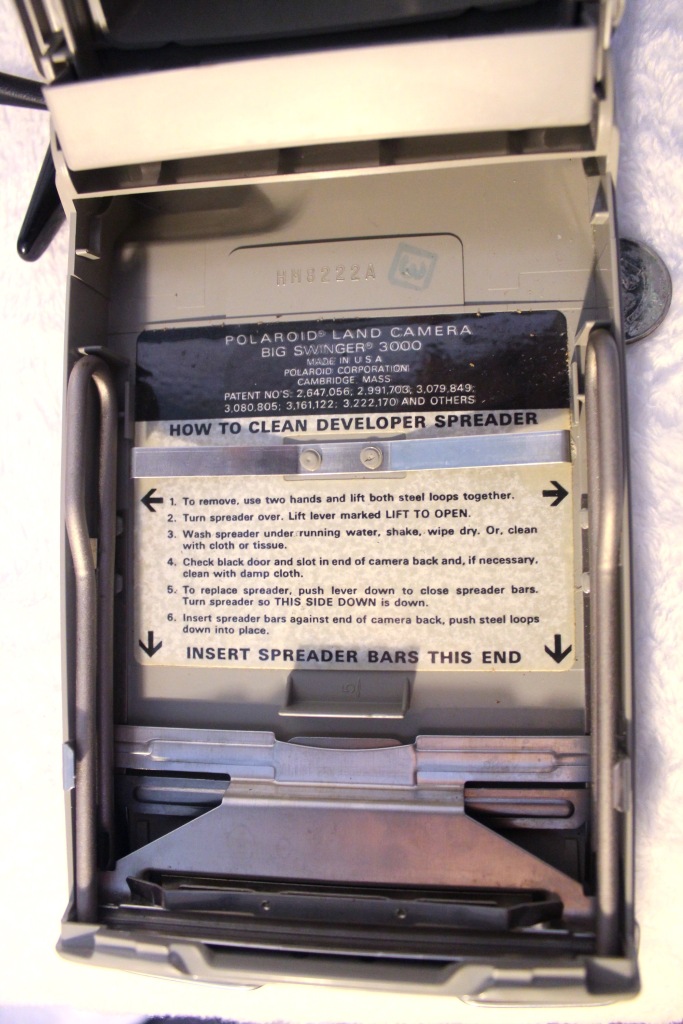“It’s more than a camera; it’s almost alive!”
What a terrifying way to advertise a camera, Polaroid… In their “Meet the Swinger” commercial, Polaroid introduces their newest instant camera, The Swinger, in 1965. Just three years later, they released the Big Swinger 3000, which I’ll be discussing today.

First, let’s talk about the name. No, it doesn’t refer to the couple-swap fad that started around the 50s. This camera is called “The (Big) Swinger” because of the strap attached to the camera with an attached T-shaped handle that allowed the camera to hang from the user’s wrist and be ‘swung’ up to take a photo. Even as the film is being developed from the camera, the instructions on the back panel ask users to allow the camera to hang while removing the film. The 3000 simply refers to the ISO speed required for the film packs.
So, what’s the difference between The Swinger and The Big Swinger? First, The Big Swinger uses type 100 pack instant film, which was produced by Fujifilm until about 2016 (though check out Supersense who is in the process of making new type 100 film), whereas the original Swinger used type 20 roll film. Another key difference is the words inside the camera. The older models included the word “NO” in the viewfinder when exposure was incorrect, whereas newer models said “YES” when exposure is correct.



Both cameras only accepted black and white film and were made almost entirely out of plastic, both of which kept costs low. At time of release, the Swinger cost $19.95 ($162.38 adjusted for inflation), and the Big Swinger 3000 cost $24.95 ($183.82).
Let’s take a look at the functionality of the camera. Since there is not film easily accessible for this model at the moment, I’m just going to focus on mechanics rather than photo quality.


The camera itself is a bit bulky in size, though surprisingly lightweight. Having a more narrow focal length at 114mm allows for close-up shots that many cameras were not able to take at the time. I will say that from the viewfinder, I can see the top of my finger on the shutter, so be careful if you find film for this camera not to include your finger in the shot. When looking through the viewfinder, you will also see a red grid under the shot. This grid lets you know when the shot is properly exposed, but should only be used when not using an AG-1 or AG-1B flashbulb. The bulb screws into the hole on the left side of the lens, while the exposure knob is on the right side next to its corresponding distance meter.



Loading the camera is fairly easy as it takes pack film. Opening the camera is self-explanatory, but if you have long nails like I do, they may be at risk when prying the metal clasp open on the side of the camera. Once open, the camera has a slot for the film pack to rest in front of the lens, and two battery slots for AA batteries to power the shutter and flash. This is an unusual feature, as many Polaroid pack film cameras have the battery in the film pack so as not to waste a flashbulb or metering power when no film is in the camera.
There is also a sticker inside the left panel providing instructions on cleaning the developer spreader. These instructions include removing the metal spreaders from the camera and running them under water, before drying them and placing them back in the camera. By cleaning the spreader, it ensures film is sent cleanly out the side of the camera and evenly developed. This camera used spreader bars instead of metal rollers to spread the developer, which were more common in previous roll film cameras.
Overall, this camera is pretty easy to handle (with the understanding that I have not tried pulling film through it), and lightweight despite its size. While not the prettiest Polaroid camera out there, it does have some vintage charm and would be simple to use, which was Polaroid’s original goal.
Quick Facts:
– Manufactured: 1968-70
– Shutter Speed: 1/200 sec
– Focal Length: 114mm
– Aperture: Between 2 and 20′ (couldn’t find f-stop)
– Original price: $24.95
– Film type: 107 black and white, ISO 3000
– Shots per pack: 8
For more information, check out the manual:
Commercial: Warning, the jingle will get stuck in your head!
Advertisements: many of these taken from eBay posts






https://en.wikipedia.org/wiki/Polaroid_Swinger
http://camera-wiki.org/wiki/Polaroid_Big_Swinger_3000
https://utahfilmphotography.com/2014/08/11/polaroid-big-swinger-model-3000-land-camera-2/
If you have any personal experience with this camera or thoughts on this post, as always feel free to comment below! I’m excited to hear from you.


Leave a comment